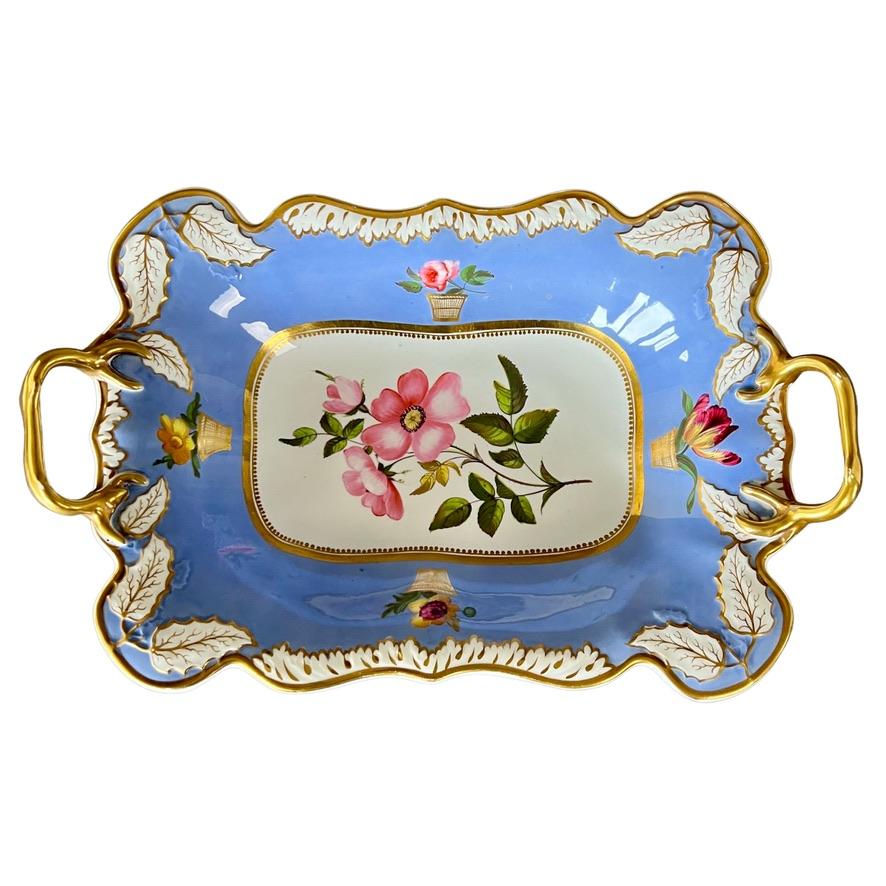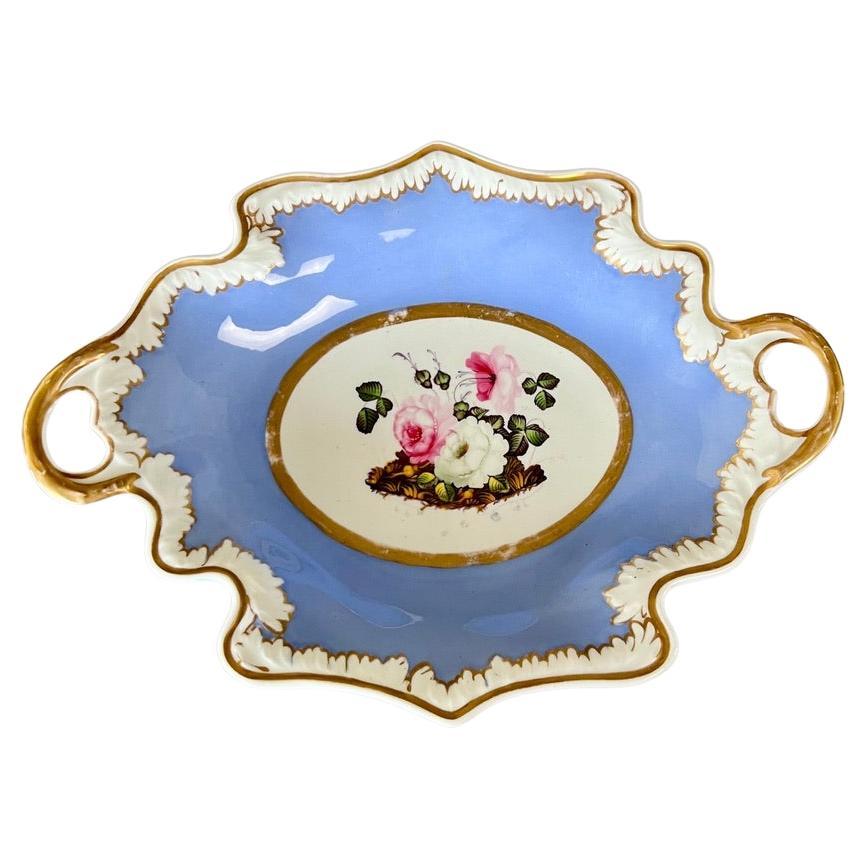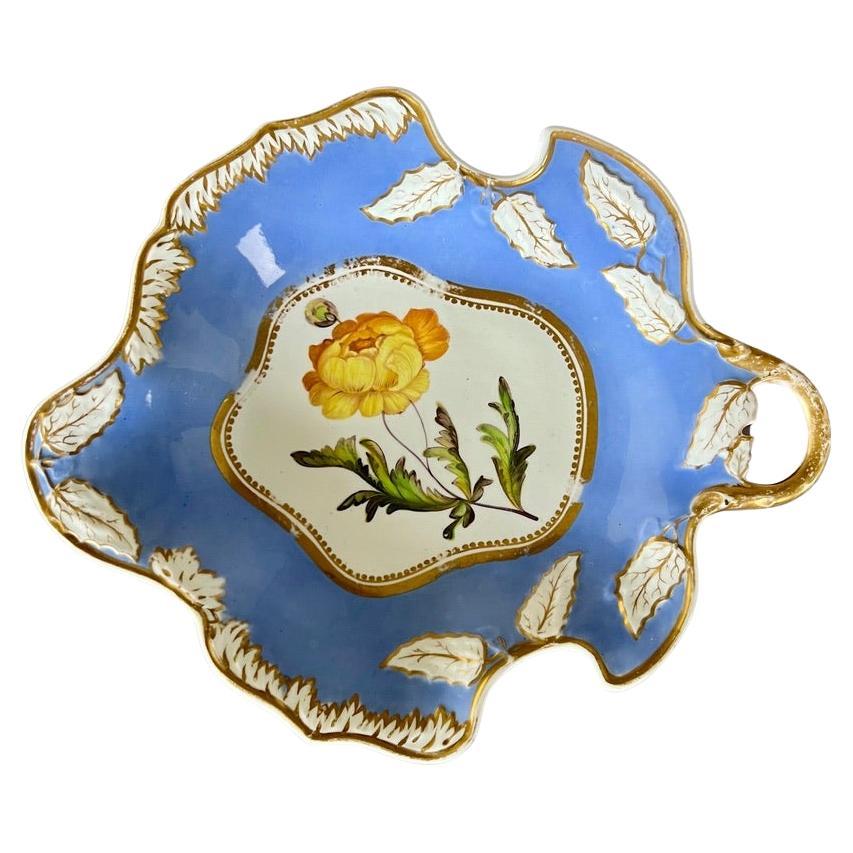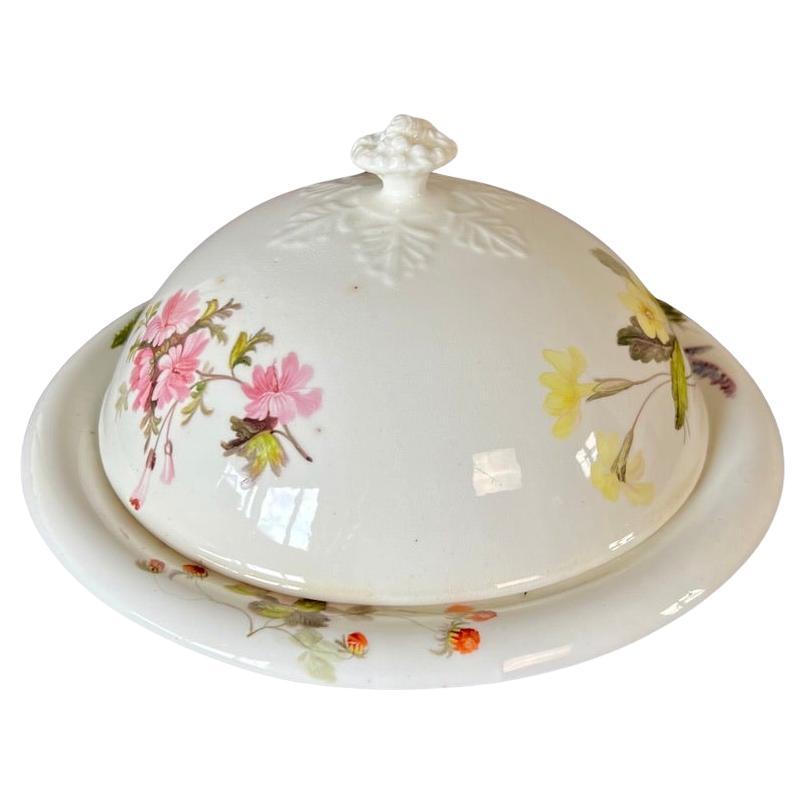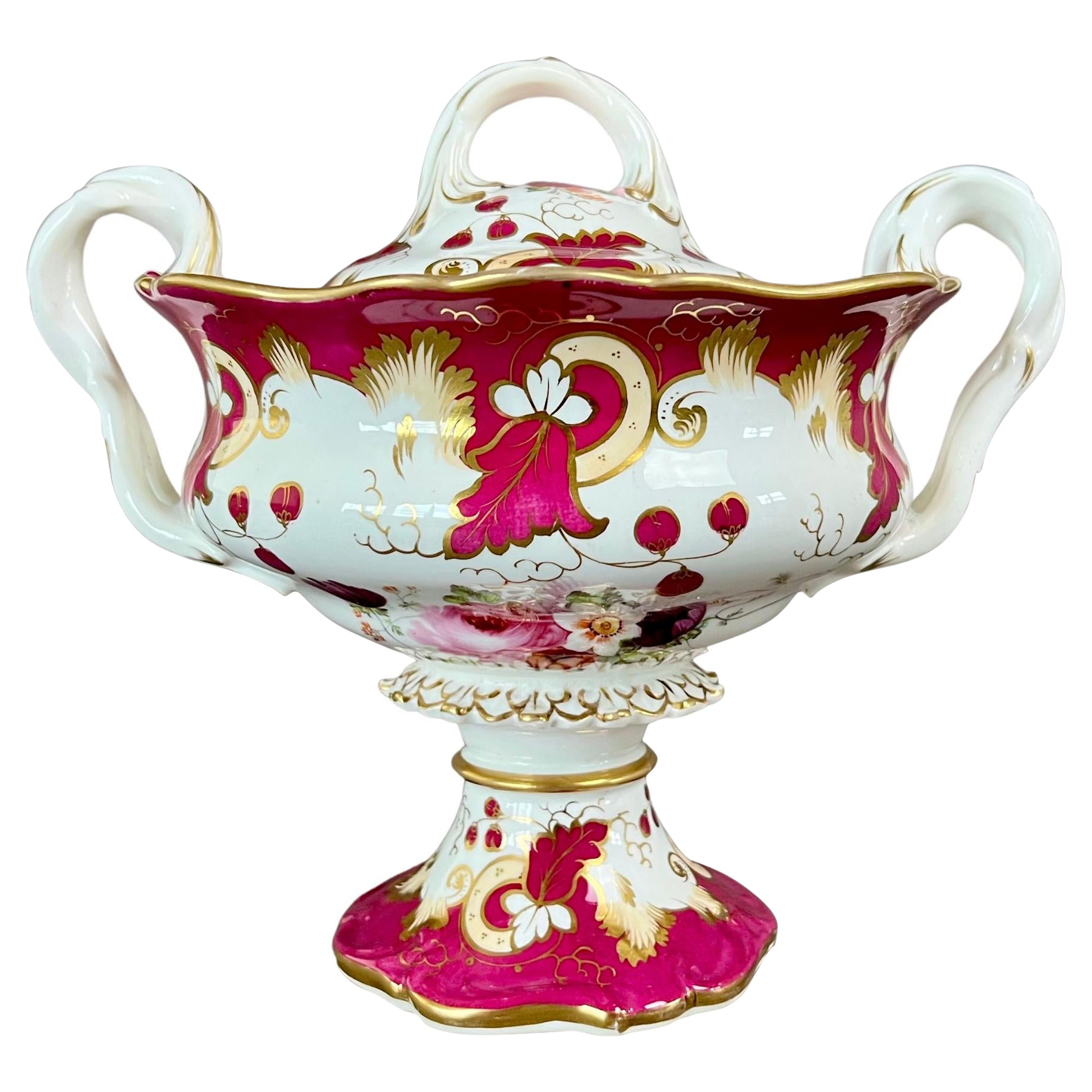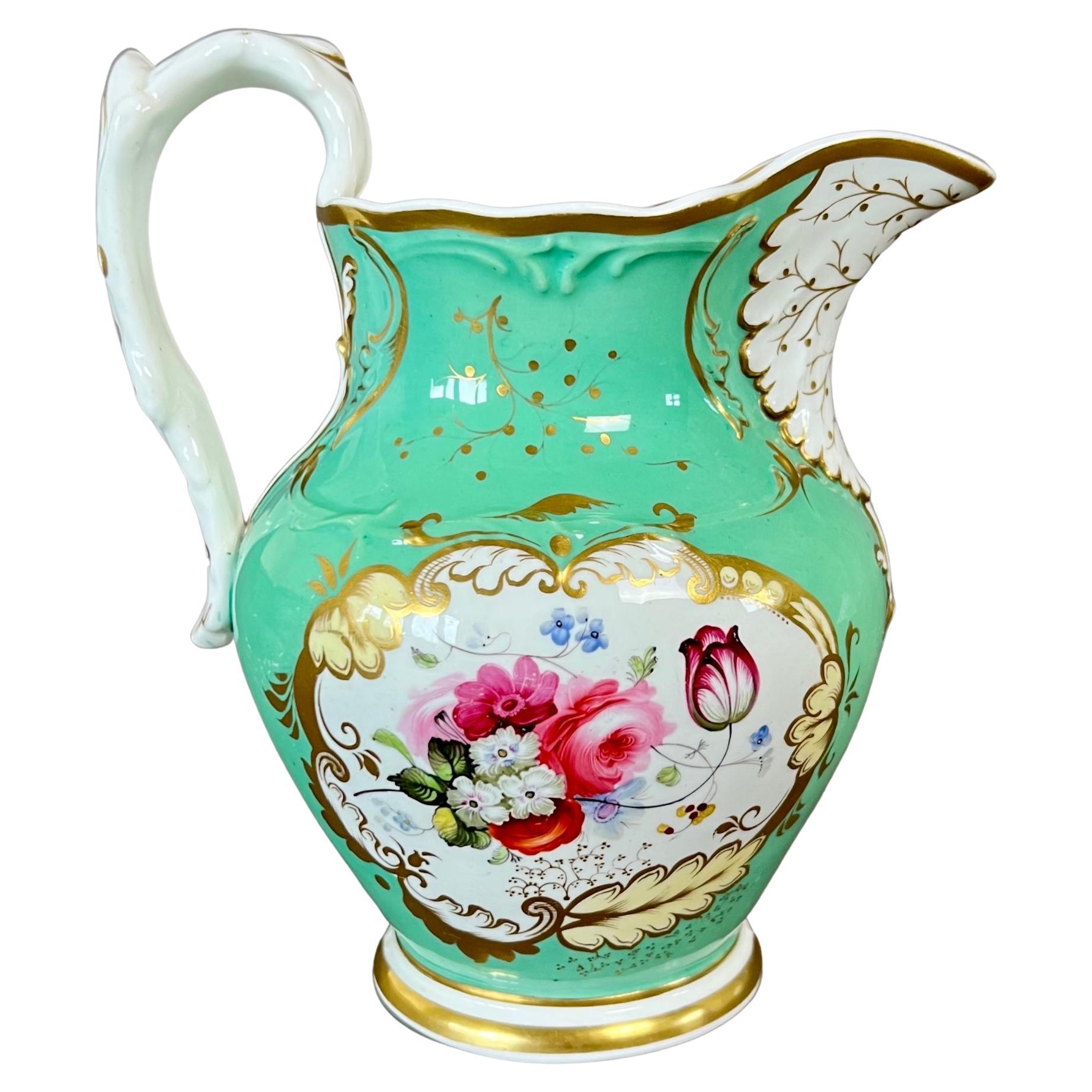Items Similar to Samuel Alcock Low Oval Comport Dish, Sage Green with Landscape, ca 1850
Want more images or videos?
Request additional images or videos from the seller
1 of 14
Samuel Alcock Low Oval Comport Dish, Sage Green with Landscape, ca 1850
About the Item
An oval low-footed comport with two handles and an octagonally scrolled shape, a moulded surface with pale yellow and white scrolling foliage on a sage green ground, and a stunning landscape in the centre of a ruin with two visitors
Pattern possibly 3/4434
Year: ca 1850
Size: 27cm X 22cm (10.5” X 8.5”)
Condition: light wear
The Samuel Alcock factory was operative in Staffordshire between 1822 and 1856, after which it was bought by Sir James Duke and Nephews. The factory started as a partnership between the young Samuel Alcock and the older Ralph Stevenson, who provided the factory and capital. Alcock quickly took the factory to great heights, building one of the biggest factories of its time. Alcock jumped on the new Rococo Revival fashion and served a huge new middle class market. The reason we now don't hear much about Samuel Alcock porcelain is that much of it has been mis-identified over the years and attributed to Coalport, Ridgway, Rockingham or others; Alcock did not mark any of his porcelain save a few rare pieces, and the numbering system is difficult to understand. However, the wares are still wide spread and many are of great quality.
This dish forms part of the Murray Pollinger Collection of Samuel Alcock Porcelain.
Murray Pollinger was a passionate collector of Samuel Alcock porcelain. He was known as a true gentleman, impeccably dressed, always kind and modest - even some of his porcelain collecting friends had no idea about the size and importance of his collection. From the mid 1980s until shortly before his death in 2022 he collected many thousands of pieces and painstakingly catalogued them. He also went on trips to Staffordshire to discover the history of Samuel Alcock from whatever little documentation has been preserved. Through his painstaking work, Pollinger was able to make sense of the pattern numbering system that was used, and this was a huge step forward in identifying and understanding the porcelain. A website with the results of his research will be made available over the course of 2023. While he sold off about half of his collection in 2016, the remaining half is now made available to a new generation of collectors.
Antique British porcelain is never perfect. Kilns were fired on coal in the 1800s, and this meant that china from that period can have some firing specks from flying particles. British makers were also known for their experimentation, and sometimes this resulted in technically imperfect results. Due to the shrinkage in the kiln, items can have small firing lines or develop crazing over time, which should not be seen as damage but as an imperfection of the maker's recipes, probably unknown at the time of making. Items have often been used for many years and can have normal signs of wear, and gilt can have signs of slight disintegration even if never handled. I will reflect any damage, repairs, obvious stress marks, crazing or heavy wear in the item description but some minor scratches, nicks, stains and gilt disintegration can be normal for vintage items and need to be taken into account.
There is widespread confusion on the internet about the difference between chips and nicks, or hairlines and cracks. I will reflect any damage as truthfully as I can, i.e. a nick is a tiny bit of damage smaller than 1mm and a chip is something you can easily see with the eye; a glazing line is a break in the glazing only; hairline is extremely tight and/or superficial and not picked up by the finger; and a crack is obvious both to the eye and the finger. Etcetera - I try to be as accurate as I can and please feel free to ask questions or request more detailed pictures!
- Creator:Samuel Alcock & Co. (Maker)
- Dimensions:Height: 2 in (5.08 cm)Width: 10.5 in (26.67 cm)Depth: 8.5 in (21.59 cm)
- Style:Victorian (Of the Period)
- Materials and Techniques:
- Place of Origin:
- Period:
- Date of Manufacture:circa 1850
- Condition:Wear consistent with age and use. excellent, light wear.
- Seller Location:London, GB
- Reference Number:
About the Seller
5.0
Platinum Seller
These expertly vetted sellers are 1stDibs' most experienced sellers and are rated highest by our customers.
Established in 2016
1stDibs seller since 2019
208 sales on 1stDibs
Typical response time: 1 hour
- ShippingRetrieving quote...Ships From: London, United Kingdom
- Return PolicyA return for this item may be initiated within 14 days of delivery.
More From This SellerView All
- Samuel Alcock Footed Comport, Melted Snow, Periwinkle Lilac, Flowers, ca 1822By Samuel Alcock & Co.Located in London, GBA footed rectangular central comport or centre piece, periwinkle / lilac ground with melted snow and holly leaf borders and flowers, a large pink wild rose painting in the centre Th...Category
Antique 1820s English Regency Serving Bowls
MaterialsPorcelain
- Samuel Alcock 2-Handled Dish, Periwinkle Blue, Lilac, with Flowers, ca 1823By Samuel Alcock & Co.Located in London, GBA two-handled leaf shaped dish with white melted snow border on a periwinkle ground, and a beautifully painted bouquet of pink and white roses in the centre There are several other ...Category
Antique 1820s English Regency Serving Bowls
MaterialsPorcelain
- Samuel Alcock Porcelain Leaf Dish, Periwinkle Blue with Yellow Flower, ca 1822By Samuel Alcock & Co.Located in London, GBA one-handled leaf dish with white melted snow and holly leaf border on a periwinkle ground, and a beautiful flower study of a yellow ranunculus in the centre There are several other items available in near-identical style, see separate listings. Pattern 507 Year: ca 1822 Size: 26cm X 21.5cm (10.25” X 8.5”) Condition: some rubbing The Samuel Alcock factory was operative in Staffordshire between 1822 and 1856, after which it was bought by Sir James Duke and Nephews. The factory started as a partnership between the young Samuel Alcock and the older Ralph Stevenson, who provided the factory and capital. Alcock quickly took the factory to great heights, building one of the biggest factories of its time. Alcock jumped on the new Rococo Revival fashion and served a huge new middle class market. The reason we now don't hear much about Samuel Alcock porcelain...Category
Antique 1820s English Regency Serving Bowls
MaterialsPorcelain
- Samuel Alcock Porcelain Muffin Dish, White, Flowers by William Pollard, ca 1826By Samuel Alcock & Co., William PollardLocated in London, GBA muffin dish with cover, simple white ground with fruit basket finial surrounded by moulded acanthus leaves, with fine flower sprays and wild strawberries by William Pollard Proven...Category
Antique 1820s English Regency Serving Bowls
MaterialsPorcelain
- Samuel Alcock Footed Porcelain Sauce Tureen, Maroon with Flower Sprays, ca 1842By Samuel Alcock & Co.Located in London, GBA footed two-handled sauce tureen with cover, maroon and pale yellow ground with beautiful hand painted flower sprays on lower part of body; twisted handles and a petticoat stem Pat...Category
Antique 1840s English Rococo Revival Serving Bowls
MaterialsPorcelain
- Samuel Alcock Cream Jug Pitcher, Pale Green with Flowers and Landscape, ca 1840By Samuel Alcock & Co.Located in London, GBA cream or water jug / pitcher with knobbed twig handle and moulded foliage under the beak, decorated in a pale green ground with a finely painted landscape on one side and rich flow...Category
Antique 1840s English Victorian Pitchers
MaterialsPorcelain
You May Also Like
- 2 Antique 19th Century English Samuel Alcock Blue Gold Floral Cups & SaucersBy Samuel Alcock & Co.Located in Dayton, OH"Four piece set of antique mid 19th century Samuel Alcock porcelain tea / coffee cups and saucers featuring turquoise blue with florals and gold gilding. Samuel Alcock (1799–1848) was a leading pottery manufacturer who operated as Samuel Alcock & Co in Burslem, Staffordshire from 1828 to 1859. They were especially noted for ""picture jugs"" modelled and moulded in relief in various ceramic materials, a popular type of object in these years. Samuel Alcock & Co. Alcock was born in Kingsley, Staffordshire. He was the youngest of the nine children of Thomas (1746–1816) and Catherine Alcock (1756–1838). Though from a farming background, he developed an interest in commerce after working with his uncle Joseph Locker, a grocer, tea dealer, provision dealer, chandler and banker of the Market Square, Hanley. His introduction to pottery came when he embarked upon a partnership with Ralph Stevenson of Cobridge, Staffordshire. In 1828, Alcock developed his own business and began work on the Hill Top site in Cobridge. By the 1830s Stevenson employed 600 people at his works. In 1839 he completed work on a large factory, built in the Venetian style, on the junction of Westport Road and Greenhead Street. In November of that year a party to celebrate the opening was held at the George Hotel...Category
Antique 19th Century Victorian Tea Sets
MaterialsPorcelain
- A fine English porcelain Punch Bowl attributed to Samuel Alcock c.1830By Samuel Alcock & Co.Located in Exeter, GBA fine English porcelain Punch Bowl attributed to Samuel Alcock c.1830. Superbly painted summer flowers to the centre interior of the bowl...Category
Antique 19th Century Porcelain
MaterialsPorcelain
- Georgian Derby Porcelain Serving Dish or Bowl Hand-Painted, Fully Marked Ca 1815By DerbyLocated in Lincoln, LincolnshireThis is a good oval shaped serving dish or bowl, made by the Derby factory, hand painted and gilded in a free flowing floral pattern, during the reign of George 111 in the early 19th century, circa 1815. This is a well potted oval shaped dish or bowl with a vertically fluted and moulded side edge and rim, sitting on a low foot. The piece is beautifully hand decorated in a free flowing manner, in one of Derby's Imari style floral Patterns, with enamels of cobalt blue, burnt orange, pink and yellow, all in varying shades. It has then been hand gilded, with gold detail to some of the flowers, blue leaf, the inner border and the outer rim. The dish has the early Derby...Category
Antique Early 19th Century English Georgian Serving Bowls
MaterialsPorcelain
- English Majolica Grapes Plate Samuel Alcock Circa 1850By Samuel Alcock & Co.Located in Austin, TXEnglish Majolica grapes plate signed Samuel Alcock Circa 1850. Rare plate decorated with grapes and strawberries.Category
Antique 1850s English Victorian Dinner Plates
MaterialsCeramic
- Four antique Royal Copenhagen porcelain bowls with hand-painted landscapes.Located in Copenhagen, DKFour antique Royal Copenhagen porcelain bowls with hand-painted landscapes and gold decoration. Museum quality. Early 19th century....Category
Antique Early 19th Century German Porcelain
MaterialsPorcelain
- Five antique Royal Copenhagen porcelain bowls with hand-painted landscapesLocated in Copenhagen, DKFive antique Royal Copenhagen porcelain bowls with hand-painted landscapes and gold decoration. Museum quality. Early 19th century...Category
Antique Early 19th Century Danish Porcelain
MaterialsPorcelain
